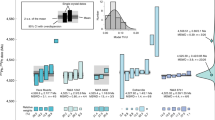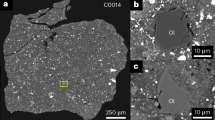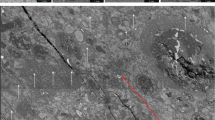Abstract
Despite the intense cratering history of the Moon, very few traces of meteoritic material have been identified in the more than 380 kg of samples returned to Earth by the Apollo and Luna missions. Here we show that an ~200-µm-sized fragment collected by the Luna 16 mission has extra-lunar origins and probably originates from an LL chondrite with similar properties to near-Earth stony asteroids. The fragment has not experienced temperatures higher than 400 °C since its protolith formed early in the history of the Solar System. It arrived on the Moon, either as a micrometeorite or as the result of the break-up of a bigger impact, no earlier than 3.4 Gyr ago and possibly around 1 Gyr ago, an age that would be consistent with impact ages inferred from basaltic fragments in the Luna 16 sample and of a known dynamic upheaval in the Flora asteroid family, which is thought to be the source of L and LL chondrite meteorites. These results highlight the importance of extra-lunar fragments in constraining the impact history of the Earth–Moon system and suggest that material from LL chondrite asteroids may be an important component.
This is a preview of subscription content, access via your institution
Access options
Access Nature and 54 other Nature Portfolio journals
Get Nature+, our best-value online-access subscription
$29.99 / 30 days
cancel any time
Subscribe to this journal
Receive 12 digital issues and online access to articles
$119.00 per year
only $9.92 per issue
Buy this article
- Purchase on Springer Link
- Instant access to full article PDF
Prices may be subject to local taxes which are calculated during checkout






Similar content being viewed by others
Data availability
The data supporting the findings in this study are available within the paper and its Supplementary Information files. Source data are provided with this paper.
References
Misra, K. & Taylor, L. A. Characteristics of metal particles in Apollo 16 rocks. Proc. Lunar Planet. Sci. Conf. 6, 615–639 (1975).
Joy, K. H. et al. The Moon: an archive of small body migration in the Solar System. Earth Moon Planets 118, 133–158 (2016).
Wood, J. A. et al. Mineralogy and Petrology of the Apollo 12 Lunar Sample Special Report 333; 177–184 (Smithsonian Astrophysical Observatory, 1971).
Haggerty, S. E. In The Apollo 15 Lunar Samples (ed. Chamberlain, J. W.) 85–87 (Lunar Science Institute, 1972).
Bischoff, A. & Stöffler, D. Shock metamorphism as a fundamental process in the evolution of planetary bodies: information from meteorites. Eur. J. Mineral. 4, 707–755 (1992).
Simon, S. B., Papike, J. J. & Laul, J. C. The lunar regolith: comparative studies of the Apollo and Luna sites. Petrology of soils from Apollo 17, Luna 16, 20, and 24. Proc. Lunar Planet. Sci. Conf. 12, 371–388 (1981).
Stöffler, D., Keil, K. & Scott, E. R. D. Shock metamorphism of ordinary chondrites. Geochim. Cosmochim. Acta 55, 3845–3867 (1991).
Fritz, J., Greshake, D. & Stöffler, D. Micro-Raman spectroscopy of plagioclase and maskelynite in Martian meteorites: evidence of progressive shock metamorphism. Antarct. Meteor. Res. 18, 96–116 (2005).
Glass, B. P. & Fries, M. Micro‐Raman spectroscopic study of fine‐grained, shock‐metamorphosed rock fragments from the Australasian microtektite layer. Meteorit. Planet. Sci. 43, 487–1496 (2008).
Farrel-Turner, S., Reimold, W. U., Niewoudt, M. & Erasmus, R. M. Raman spectroscopy of olivine in dunite experimentally shocked to pressures between 5 and 59 GPa. Meteorit. Planet. Sci. 40, 1311–1327 (2005).
Nakamura, T. et al. Itokawa dust particles: a direct link between S-type asteroids and ordinary chondrites. Science 333, 1113–1116 (2011).
Noguchi, T. et al. Mineralogy of four Itokawa particles collected from the first touchdown site. Earth Planets Space 66, 124 (2014).
Nazarov, M. A., Ntaflos, Th., Brandstätter, F. & Kurat, G. FeO/MnO ratios of lunar meteorite minerals. In 40th Lunar and Planetary Science Conference 1059 (Lunar and Planetary Institute, 2009).
Galimov, E. M. et al. Analytical results for the material of the Chelyabinsk meteorite. Geochem. Int. 51, 522–539 (2013).
Niihara, T., Yokoyama, T., Arai, T. & Misawa, K. Petrology and mineralogy of an igneous clast in the northwest Africa 1685 (LL4) chondrite: comparison with alkali-rich igneous clasts in LL-chondritic breccias. Meteorit. Planet Sci. 56, 1619–1625 (2021).
Mikouchi, T. et al. Mineralogy and crystallography of some Itokawa particles returned by the Hayabusa asteroidal sample return mission. Earth Planets Space 66, 82 (2014).
Warren, P. H. A concise compilation of petrologic information on possibly pristine nonmare Moon rocks. Am. Mineral. 78, 360–376 (1993).
Semenova, A. S., Kononkova, N. N. & Guseva, E. V. Olivine-hypersthene chondrite in Luna 16 soil. In 21st Lunar and Planetary Science Conference 1126–1127 (Lunar and Planetary Institute, 1990).
Snape, J. F. et al. Phosphate ages in Apollo 14 breccias: resolving multiple impact events with high precision U–Pb SIMS analyses. Geochim. Cosmochim. Acta 174, 13–29 (2016).
Connelly, J. N., Bollard, J. & Bizzarro, M. Pb–Pb chronometry and the early Solar System. Geochim. Cosmochim. Acta 201, 345–363 (2017).
Merle, R. et al. Exploring the efficiency of stepwise dissolution in removal of stubborn non-radiogenic Pb in chondrule U–Pb dating. Geochim. Cosmochim. Acta 277, 1–20 (2020).
Clayton, R. N., Mayeda, T. K., Goswami, J. N. & Olsen, E. J. Oxygen isotope studies of ordinary chondrites. Geochim. Cosmochim. Acta 55, 2317–2337 (1991).
Yurimoto, H. et al. Oxygen isotopic compositions of asteroidal materials returned from Itokawa by the Hayabusa mission. Science 333, 1116–1119 (2011).
Nakashima, D. et al. Oxygen three-isotope ratios of silicate particles returned from asteroid Itokawa by the Hayabusa spacecraft: a strong link with equilibrated LL chondrites. Earth Planet. Sci. Lett. 379, 127–136 (2013).
Van Schmus, W. R. & Wood, J. A. A chemical–petrologic classification for the chondritic meteorites. Geochim. Cosmochim. Acta 31, 747–765 (1967).
Rubin, A. E. Kamacite and olivine in ordinary chondrites: intergroup and intragroup relationships. Geochim. Cosmochim. Acta 54, 1217–1232 (1990).
McSween, H. Y. & Labotka, T. C. Oxidation during metamorphism of the ordinary chondrites. Geochim. Cosmochim. Acta 57, 1105–1114 (1993).
Dunn, T. L., McSween, H. Y. Jr., McCoy, T. J. & Cressey, G. Analysis of ordinary chondrites using powder X-ray diffraction: 2. Applications to ordinary chondrite parent-body processes. Meteorit. Planet. Sci. 45, 135–156 (2010).
Rubin, A. E. Relationships among intrinsic properties of ordinary chondrites: oxidation state, bulk chemistry, oxygen-isotopic composition, petrologic type, and chondrule size. Geochim. Cosmochim. Acta 69, 4907–4918 (2005).
Moyano-Cambero C. E. et al. In Assessment and Mitigation of Asteroid Impact Hazards (eds. Trigo-Rodríguez, J. M., Gritsevich, M. & Palme, H.) 219–241 (Springer, 2017).
Vernazza, P. et al. Compositional differences between meteorites and near-Earth asteroids. Nature 454, 858–860 (2008).
Bollard, J. et al. Early formation of planetary building blocks inferred from Pb isotopic ages of chondrules. Sci. Adv. 3, e1700407 (2017).
Swindle, T. D., Kring, D. A. & Weirich, J. R. In Advances in 40Ar/39Ar Dating: from Archaeology to Planetary Sciences (eds. Jaurdan, F., Marc, D. & Vérati, C.) 333–347 (Geological Society of London, 2014).
Pierazzo, E. & Melosh, H. J. Understanding oblique impacts from experiments, observations, and modeling. Annu. Rev. Earth Planet. Sci. 28, 141–167 (2000).
Daly, R. T. & Schultz, P. H. Experimental studies into the survival and state of the projectile. In 44th Lunar and Planetary Science Conference 2240 (Lunar and Planetary Institute, 2013).
Chamberlain, K. R. & Bowring, S. A. Apatite–feldspar U–Pb thermochronometer: a reliable, mid-range (~450 °C), diffusion controlled system. Chem. Geol. 172, 73–200 (2000).
Papanastassiou, D. A. & Wasserburg, G. J. Rb–Sr age of a Luna 16 basalt and the model age of lunar soils. Earth Planet. Sci. Lett. 13, 368–374 (1972).
Cohen, B. A., Snyder, G. A., Hall, C. M., Taylor, L. A. & Nazarov, M. A. Argon-40–argon-39 chronology and petrogenesis along the eastern limb of the Moon from Luna 16, 20 and 24 samples. Meteorit. Planet. Sci. 36, 1345–1366 (2001).
Tsuchiyama, A. Asteroid Itokawa a source of ordinary chondrites and a laboratory for surface processes. Elements 10, 45–50 (2015).
Park, J. et al. 40Ar/39Ar age of material returned from asteroid 25143 Itokawa. Meteorit. Planet. Sci. 50, 2087–2098 (2015).
Terada, K. et al. Thermal and impact historyies of 25143 Itokawa recorded in Hayabusa particles. Sci. Rep. 8, 11806 (2018).
Dykhuis, M. J., Molnar, L., Van Kooten, S. J. & Greenberg, R. Defining the Flora family: Orbital properties, reflectance properties and age. Icarus 243, 111–128 (2014).
Tsuchiyama, A. et al. Three-dimensional structure of Hayabusa samples: origin and evolution of Itokawa regolith. Science 333, 1125–1128 (2011).
Nagao, K. et al. Irradiation history of Itokawa regolith material deduced from noble gases in the Hayabusa samples. Science 333, 1128–1131 (2011).
Tatsumi, E. & Sugita, S. Cratering efficiency on coarse-grain targets: implications for the dynamical evolution of asteroid 25143 Itokawa. Icarus 300, 227–248 (2018).
Tanbakouei, S. et al. Mechanical properties of particles from the surface of asteroid 25143 Itokawa. Astron. Astrophys. 629, A119 (2019).
The Meteoritical Bulletin Database (The Meteoritical Society, accessed 1 July 2021); https://www.lpi.usra.edu/meteor/metbull.php
Genge, M. J., Engrand, C., Gounelle, M. & Taylor, S. Micrometeorites: insights into the flux, sources and atmospheric entry of extraterrestrial dust at Earth. Planet. Space Sci. 187, 104900 (2020).
Hallis, L. J. et al. The oxygen isotope composition, petrology and geochemistry of mare basalts: evidence for large-scale compositional variation in the lunar mantle. Geochim. Cosmochim. Acta 74, 6885–6899 (2010).
Dunn, T. L., Cressey, G., Mcsween, H. Y. Jr. & McCoy, T. J. Analysis of ordinary chondrites using powder X-ray diffraction: 1. Modal mineral abundances. Meteorit. Planet. Sci. 45, 123–134 (2010).
Nemchin, A. A. et al. Record of the ancient Martian hydrosphere and atmosphere preserved in zircon from a Martian meteorite. Nat. Geosci. 7, 638–642 (2014).
Whitehouse, M. J. & Nemchin, A. A. High precision, high accuracy measurement of oxygen isotopes in a large lunar zircon by SIMS. Chem. Geol. 261, 32–42 (2009).
Kita, N. T. et al. High precision SIMS oxygen three isotope study of chondrules in LL3 chondrites: role of ambient gas during chondrule formation. Geochim. Cosmochim. Acta 74, 6610–6635 (2010).
Eiler, J. M., Graham, C. & Valley, J. W. SIMS analysis of oxygen isotopes: matrix effects in complex minerals and glasses. Chem. Geol. 138, 221–244 (1997).
Duggen, S. et al. Drastic shift in lava geochemistry in the volcanic-front to rear-arc region of the southern Kamchatkan subduction zone: evidence for the transition from slab surface dehydration to sediment melting. Geochim. Cosmochim. Acta 71, 452–480 (2007).
Yarosewich, E. J., Nelen, J. A. & Norberg, J. A. Reference sample for electron microprobe analysis. Geostand. Newsl. 4, 43–47 (1980).
Isa, J. et al. Quantification of oxygen isotope SIMS matrix effects in olivine samples: correlation with sputter rate. Chem. Geol. 458, 14–21 (2017).
Deegan, F. M. et al. Pyroxene standards for SIMS oxygen isotope analysis and their application to Merapi Volcano, Sunda arc, Indonesia. Chem. Geol. 447, 1–10 (2016).
Whitehouse, M. J. Multiple sulfur isotope determination by SIMS: evaluation of reference sulfides for Δ33S with observations and a case study on the determination of Δ36S. Geostand. Geoanal. Res. 37, 19–33 (2013).
Liseroudi, M. H. et al. Microbial and thermochemical controlled sulfur cycle in the Early Triassic sediments of the Western Canadian Sedimentary Basin. J. Geol. Soc. 178, jgs2020-175 (2021).
Crowe, D. E. & Vaughan, R. G. Characterization and use of isotopically homogeneous standards for in situ laser microprobe analysis of 34S/32S ratios. Am. Mineral. 81, 187–193 (1996).
Cabral, R. A. et al. Anomalous sulphur isotopes in plume lavas reveal deep mantle storage of Archaean crust. Nature 496, 490–493 (2013).
Whitehouse, M. J., Kamber, B. S., Fedo, C. M. & Lepland, A. The importance of combined Pb and S isotope data from early Archaean rocks, southwest Greenland, for the interpretation of S-isotope signatures. Chem. Geol. 222, 112–131 (2005).
Baublys, K. A., Golding, S. D., Young, E. & Kamber, B. S. Simultaneous determination of δ33SV‐CDT and δ34SV‐CDT using masses 48, 49 and 50 on a continuous flow isotope ratio mass spectrometer. Rapid Commun. Mass Spectrom. 18, 2765–2769 (2004).
Woodhead, J. D. & Hergt, J. M. Pb‐isotope analyses of USGS reference materials. Geostand. Newsl. 24, 33–38 (2000).
Grange, M. L. et al. Thermal history recorded by the Apollo 17 impact melt breccia 73217. Geochim. Cosmochim. Acta 73, 3093–3107 (2009).
Stern, R. A. & Amelin, Y. Assessment of errors in SIMS zircon U–Pb geochronology using a natural zircon standard and NIST SRM 610 glass. Chem. Geol. 197, 111–142 (2003).
Stacey, J. S. & Kramers, J. D. Approximation of terrestrial lead isotope evolution by a two-stage model. Earth Planet. Sci. Lett. 26, 207–221 (1975).
Steiger, R. H. & Jäger, E. Subcommission on geochronology: convention on the use of decay constants in geo-and cosmochronology. Earth Planet. Sci. Lett. 36, 359–362 (1977).
Acknowledgements
We thank F. Kirally (Vienna University) and D. Topa (NHM Vienna) for their help with microprobe analyses. S.I.D. acknowledges the support of the Ministry of Science and Higher Education of the Russian Federation under the grant 075-15-2020-780 (N13.1902.21.0039). M.J.W., A.A.N. and R.M. acknowledge support from Swedish Research Council (VR) grants 2017-04151 and 2020-03828. The NordSIMS facility is supported by VR research infrastructure grant 2017-00671; this is NordSIMS publication 704.
Author information
Authors and Affiliations
Contributions
S.I.D. initiated the investigation of the fragment. F.B., Th.N. and S.I.D. conducted the chemical characterization of mineral phases. G.G.K., R.M. and S.I.D. contributed to the SEM mapping of the sample; I.D. performed the Raman analyses. M.J.W. and R.M. conducted the SIMS isotopic studies. S.I.D. produced the first draft of the manuscript. M.J.W., A.A.N. and R.M. contributed writing the final version of the manuscript. All authors were involved in discussion and interpretation of the obtained data.
Corresponding author
Ethics declarations
Competing interests
The authors declare no competing interests.
Peer review
Peer review information
Nature Astronomy thanks Josep Trigo-Rodriguez, Thomas Zega and Barbara Cohen for their contribution to the peer review of this work.
Additional information
Publisher’s note Springer Nature remains neutral with regard to jurisdictional claims in published maps and institutional affiliations.
Supplementary information
Supplementary Information
Supplementary Figs. 1–4, Tables 1–5 and references.
Source data
Source Data Fig. 1
Mineral composition summary.
Source Data Fig. 2
SIMS oxygen isotope data.
Source Data Fig. 3
SIMS U–Pb data.
Source Data Fig. 4
Electron microprobe analysis data of some minerals.
Source Data Fig. 5
Modal composition of the fragment.
Rights and permissions
About this article
Cite this article
Demidova, S.I., Whitehouse, M.J., Merle, R. et al. A micrometeorite from a stony asteroid identified in Luna 16 soil. Nat Astron 6, 560–567 (2022). https://doi.org/10.1038/s41550-022-01623-0
Received:
Accepted:
Published:
Issue Date:
DOI: https://doi.org/10.1038/s41550-022-01623-0



